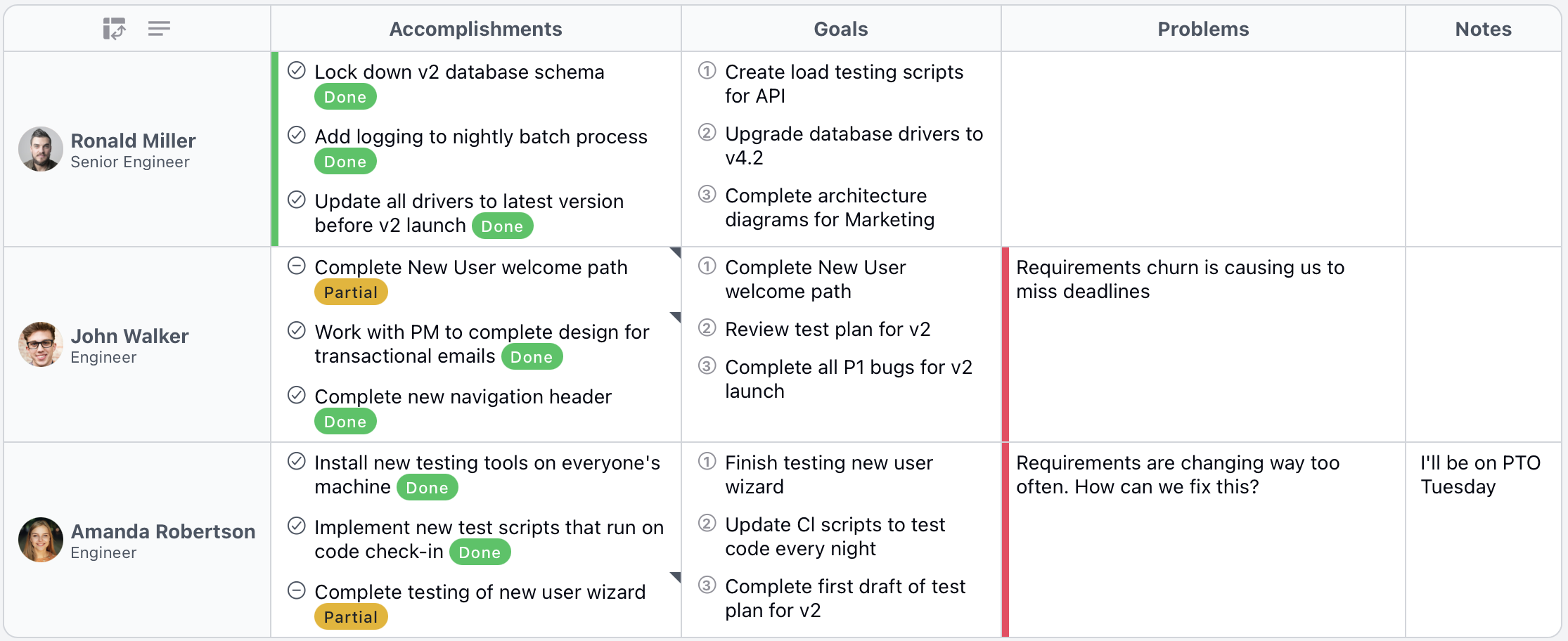Team Alignment - Everyone Actually on the Same Page
The "Same Page" Problem Every Team Faces
You know this scenario: You walk into Monday's meeting confident about the plan, only to discover that half your team interpreted last week's decisions completely differently. Sarah thought the deadline moved to next month. Mike assumed the client requirements changed. Jennifer started working on a completely different approach.
The result: Hours of backtracking, confused customers, missed deadlines, and that sinking feeling that your team is fundamentally disconnected despite sitting in the same room (or Zoom call) every week.
The deeper problem: Teams think they're aligned when they're actually operating from different assumptions, incomplete information, and outdated understanding.
Why Teams Fall Out of Sync
Information Silos Create Parallel Realities
Where team alignment breaks down:
- Manager-only context - Important decisions stay trapped in leadership conversations
- One-on-one drift - Individual conversations create inconsistent understanding
- Email assumptions - "Did everyone see that update I sent?"
- Meeting memory gaps - People remember different parts of the same discussion
- Timing delays - Updates reach team members at different times and in different contexts
The Compound Effect of Misalignment
Small miscommunications create major problems:
- Week 1: Slightly different interpretation of priorities
- Week 2: Work diverges based on different assumptions
- Week 3: Conflicts emerge as incompatible approaches clash
- Week 4: Crisis mode as deadlines loom with incomplete coordination
Real cost example: A product team spent 3 weeks building features based on outdated requirements because the scope change was only communicated in a manager's email that two developers missed.
Kutano's Shared Reality Solution
The Digital Team Whiteboard That Actually Works
Imagine if your team had a magic whiteboard that was updated every Monday with the most important information about what each person accomplished last week and is planning for the upcoming week, and everyone could see the complete picture at the same time.
That's exactly what Kutano's status form provides:
- Key information across the top - Priorities, progress, obstacles, wins
- Names down the side - Every team member gets their own row
- Weekly rhythm - Everyone updates their section each week, creating a consistent shared view
- Shared visibility - Everyone sees exactly the same information every Monday
The transformation: Instead of wondering "What is everyone working on?" you get a complete team picture every week. Instead of guessing "Are we aligned?" you have visible proof of priorities and progress.

What "Same Page" Actually Looks Like
Before Kutano (Different pages):
- Manager: "I think the team understands the new priorities"
- Developer A: "I'm working on the client request from last week"
- Developer B: "I thought we were focusing on the internal tool"
- Designer: "Nobody told me the timeline changed"
With Kutano (Literally the same page):
- Everyone sees the same priority list updated each Monday
- Progress is visible to all team members through weekly summaries
- Changes are communicated through the shared weekly status form
- Alignment is verifiable every week, not assumed
The result: Teams operate from shared facts refreshed weekly instead of individual assumptions that drift over time.
The Power of Shared Visibility
Immediate Benefits Teams Experience
Week 1: Awareness
- "Oh, I can actually see what everyone is working on"
- "This makes so much more sense than our scattered updates"
- "Finally, I understand how my work fits with the team"
Week 2: Coordination
- Natural collaboration emerges as people see connections
- Conflicts get resolved before they become problems
- Dependencies become obvious and manageable
Week 3: Confidence
- Managers stop wondering if their team is aligned
- Team members feel confident they're working on the right things
- Stakeholders can see real progress without constant check-ins
Week 4+: Strategic Advantage
- Faster decision-making because everyone has context
- Better resource allocation because workload is visible
- Higher team performance through natural coordination
Real-World Transformation Examples
Marketing Team Success:
"Before Kutano, our campaigns were constantly stepping on each other. Now we see everyone's launch dates, target audiences, and resource needs in one place. We went from campaign conflicts every month to seamless coordination."
Product Development Team:
"Our biggest problem was engineers and designers getting out of sync. Now everyone sees the same feature priorities, timeline changes, and customer feedback. Our delivery predictability improved by 60%."
Remote Team Coordination:
"Managing a distributed team felt impossible—different time zones, different communication styles, different understanding of priorities. Kutano's weekly summaries gave us a single source of truth that works whether you're in California or Copenhagen. Everyone starts Monday with the same understanding of team progress."
Beyond "Same Page" to Strategic Alignment
Most teams settle for basic coordination. Kutano enables something more powerful: strategic coherence where every team member understands not just what they're doing, but why it matters and how it connects to everyone else's work.
The compound effect:
- Individual level: Higher job satisfaction because work feels meaningful and connected
- Team level: Faster execution because coordination happens naturally
- Organization level: Strategic goals achieved reliably because teams operate as unified systems
Your next step: Stop accepting miscommunication as "just how teams work."
Try Kutano free and experience what it feels like when your entire team is genuinely on the same page.